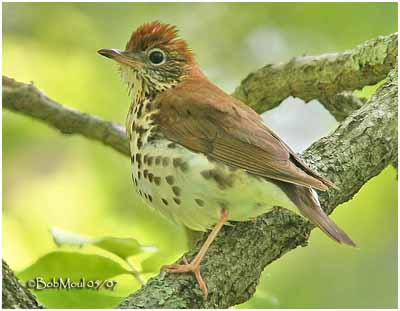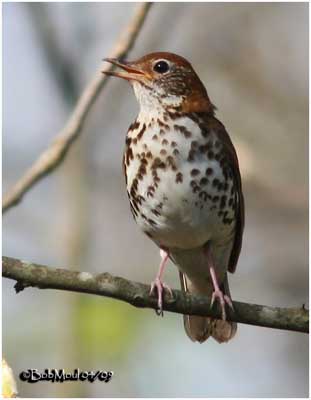
Wood Thrush
Hylocichla mustelina
Passeriforme Order – Turdidae Family
BIOMETRICS:
Length: 19-21 cm
Wingspan: 30-34 cm
Weight: 40-50 g
LONGEVITY: Up to 8 years
DESCRIPTION:
Wood Thrush has reddish brown crown, forehead and nape. Upperparts are mostly olive brown. Underparts are white, spotted with dark brown on breast and flanks.
Face is white, finely streaked with dark brown. We can see a white eye ring. Eyes are dark brown. Bill is blackish. Legs and feet are pinkish brown.
Both sexes are similar.
Juvenile resembles adults, with more spots on upperparts.
Fr: Grive des bois
All : Walddrossel
Esp : Zorzal Maculado
Ital : Tordo dei boschi americano
Nd : Amerikaanse Boslijster
Sd : Fläckskogstrast
Photographs by Bob Moul
His website :
Nature Photography
Text by Nicole Bouglouan
Sources:
HANDBOOK OF THE BIRDS OF THE WORLD Vol 10 by Josep del Hoyo-Andrew Elliott-David Christie - Lynx Edicions - ISBN: 8487334725
FIELD GUIDE TO THE BIRDS OF NORTH AMERICA - National Geographic Society - ISBN: 0792274512
L’ENCYCLOPEDIE MONDIALE DES OISEAUX - Dr Christopher M. Perrins - BORDAS - ISBN: 2040185607
A GUIDE TO THE BIRDS OF MEXICO AND NORTHERN CENTRAL AMERICA by Steve N. G. Howell, Sophie Webb - Oxford University Press - ISBN: 0198540124
All About Birds (Cornell Lab of Ornithology)
Animal Diversity Web (University of Michigan Museum of Zoology)

VOICE: SOUNDS BY XENO-CANTO
Wood Thrush starts to sing when arrives on breeding areas. Song includes loud musical phrases, with 3 to 5 notes in different tonalities, ending in soft and guttural trill. Male sings mostly at dawn and dusk.
Call is a rapid “pit-pit-pit”. When alarmed, it utters a “bup-bup” or “tut-tut”.
Wood Thrush may sing two notes at once, uttering a flute-like song.
HABITAT:
Wood Thrush breeds in deciduous and mixed forests with shrub layer. They need tall trees, open forest floor, moist soil and leaf litter. They need places near streams and rivers. It is a bird of the interior forest, but sometimes it is found on the edges.
Wood Thrush winters in lowland tropical primary forests.
RANGE:
Wood Thrush breeds in eastern North America, from southern Canada to northern Florida, and from Atlantic coast to eastern Great Plains in Texas.
They winter in Mexico and Central America.

BEHAVIOUR:
Wood Thrush feeds mainly on the ground, but it may glean in foliage in trees. It hops around on the ground, using its bill to turn over leaves, searching for prey. It also probes the soil with its bill, for insect larvae and invertebrates.
In spring, males arrive first, and establish territories. They sing from perches, high in trees at the beginning of breeding season, and later, they sing from lower perches. Each bird has its own repertoire of songs.
To defend its territory, male performs agonistic display, but it may have a brief contact with feet and bill between male and intruder. It also may flick wings and tail, with raised crest and fluffed breast feathers.
Courtship displays show the male chasing female, both performing circular flights at 1 to 2 metres from the ground. They may repeat several times these displays. Between each flight, male and female perch together and perform mutual courtship feeding.
Wood Thrush’s nest is often parasitized by Brown-headed Cowbird.
Parents return each year to the same breeding areas.
Wood Thrush sometimes practices “anting”, rubbing ants on its feathers, probably to get defensive secretions from ants.

FLIGHT:
Wood Thrush migrates at night, mostly along the coasts.
REPRODUCTION:
Wood Thrush female chooses the nest site and builds the nest. It is cup-shaped, made with dried grasses, dead leaves, mosses and rootlets. We can see a white bit of paper or cloth at the base. Nest is lined with mud and rootlets, and situated on lower branches in trees or shrubs, in a shady area, between 3 to 5 metres above the ground.
Female lays 3 to 4 pale blue eggs. Incubation lasts about 13 to 14 days, by female. Both parents feed the altricial chicks which remain about 12 to 15 days in the nest. They are fed by parents until they become independent, and they leave the territory at 21 to 31 days old. Young are fed both insects and berries. They reach their sexual maturity at one year.
This species produces two broods per season.
DIET:
Wood Thrush feeds on invertebrates such as beetles, flies, earthworms and spiders. They also consume fruits and berries at all the time of the year.

PROTECTION/THREATS/ STATUS:
Tropical deforestation in lowlands of Central America is an important fact which explains some decline in populations of Wood Thrush. This species is highly dependent of mature forests in its range.
Wood Thrush broods are parasitized by Brown-headed Cowbird.
Eggs and chicks are vulnerable to some predators, such as raccoons, jays, crows, black rat snakes, squirrels, weasels, cats, owls and hawks.
Adults are good preys for owls and hawks.